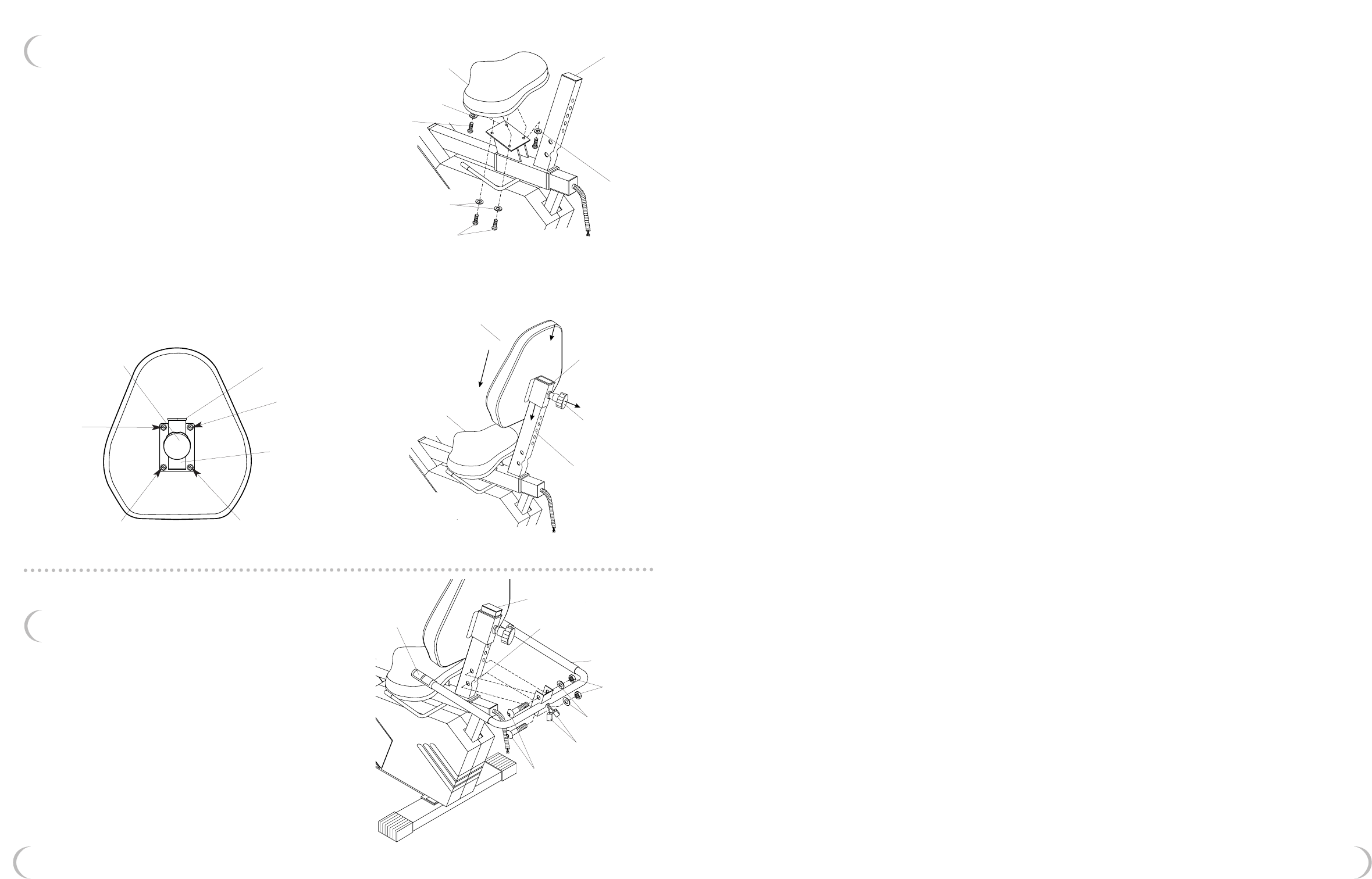
218
seat carriage
notch
rear
handlebar
M8 nylon
nuts
M8 washers
M8 x 45mm
allen
bolts
handlebar
pulse wires
pulse
sensor
STEP 5 – Rear Handlebar Assembly
a) Remove (2) Allen Bolts, (2) Washers and (2) Nylon
Nuts from Rear Handlebar with Pulse Sensors.
b) Place Rear Handlebar into notch in Seat
Carriage with Handlebar pointing forward
and Pulse Sensors facing up, see Figure 5.
c) Secure Rear Handlebar with (2) Allen Bolts,
(2) Washers and (2) Nylon Nuts removed in
Step 5a. Tighten Bolts with Allen Wrench
provided.
Figure 5 - Install Rear Handlebar
STEP 4 – Seat Cushion and Backrest Installation
seat
cushion
seat
carriage
M6 x 15mm
phillips bolts
M6 washer
M6
washers
M6 x 15mm
phillips bolts
M6 washer
Figure 4c - Install Backrest
Figure 4a - Install Seat
Figure 4b - Install Seat Carriage Slider
a) Position Seat Cushion over lower Seat Carriage
with narrow side pointing forward and align bolt
holes. Secure with (4) Phillips Bolts and (4) Washers
from fastener pack and tighten, see Figure 4a.
b) Place Backrest upside down on a flat surface,
see Figure 4b.
c) Position Seat Carriage Slider on Backrest, as shown in
Figure 4b, with Height Adjustment Knob facing away
from Backrest and Seat Carriage Bushing towards top
of Backrest. Attach using (4) Phillips Bolts and (4)
Washers from fastener pack. Tighten bolts.
d) Pull Height Adjustment Knob out and slide Backrest
onto Seat Carriage. Note: Slide the side opposite of
the Seat Carriage Bushing on first. Release Height
Adjustment Knob and continue to slide Backrest
down until it clicks into an adjustment hole.
Turn knob to lock into place, see Figure 4c.
backrest
seat
cushion
M6 x 15mm
phillips bolt
and
M6 washer
M6 x 15mm phillips bolt and M6 washer
seat carriage slider
M6 x 15mm
phillips bolt
and
M6 washer
seat carriage bushing
goes towards top of seat
height
adjustment
knob
top of backrest
seat
carriage
bushing
height
adjustment
knob
seat
carriage
individual would need to keep their heart rate
at or above 126 beats per minute to get a
cardiovascular effect. Note: Although 70% was
used in this example, the heart rate range needed
to achieve results falls between 60% and 85% of
your maximum heart rate.
If you are just beginning your exercise program,
your target heart rate range should be roughly at
60% of your maximum heart rate. As you become
more conditioned (or if you are already in good
cardiovascular shape) you can increase your
target heart rate to 70% - 85% of your maximum
heart rate. Remember, your target heart rate is
only a guide.
When checking heart rate during a workout, take
your pulse within five seconds after interrupting
exercise because it starts to go down once you
stop moving. Count pulse for 10 seconds and
multiply by six to get the per-minute rate.
Remember, your bike also comes with pulse sensors
located on the Rear Handlebar.
When used properly, the unit pulse sensors
can help you to determine your estimated
heart rate. To do so:
a) Push the START button on your computer.
b) Gently grab both metal pulse sensors on
both handlebars. Wait 6 seconds.
c) Your estimated heart rate range will be
displayed on screen. Check the chart on the
following page to see if you are within your
range according to your age.
When used properly, the heart rate pulse
sensors and display monitor provide a
reasonably accurate estimate of your
actual heart rate. This estimate is not
exact and persons with medical conditions
and/or a specific need for accurate heart
rate monitoring should not rely on the
estimations provided.
By using the chart on the following page, you can
see where your heart rate falls in the minimum and
maximum target zones.
The above are guidelines, people with any medical
limitations should discuss this formula with their
physician.
CLOTHING
All exercise clothing should be loose-fitting to
permit freedom of movement, and should make
the wearer feel comfortable and self-assured.
Never wear rubberized or plastic clothing, such
garments interfere with the evaporation of
perspiration and can cause body temperature
to rise to dangerous levels.
We recommend wearing a workout shoe with a
rubberized sole unless instructed otherwise.
TIPS TO KEEP YOU GOING
1) Adopt a specific plan and write it down.
2) Keep setting realistic goals as you go along,
and remind yourself of them often.
3) Keep a log to record your progress and make
sure to keep it up-to-date. See pages 26-28.
4) Include weight and/or percent body fat
measures in your log. Extra pounds can
easily creep back.
5) Upgrade your fitness program as you progress.
Your bike provides 12 different workout
programs to keep your workouts challenging.
6) Enlist the support and company of your family
and friends.
7) Update others on your successes.
8) Avoid injuries by pacing yourself and including
a warm up and cool down period as part of
every workout. See page 23-24.
9) Reward yourself periodically for a job well done!

















